Northern Mongolian “eternal ice” is melting for the first time in memory, threatening the traditional reindeer-herding lifestyle and exposing fragile cultural artifacts to the elements, according to a study published November 20, 2019 in the open-access journal PLOS ONE by William Taylor from the Max Planck Institute, Germany, and the University of Colorado-Boulder, USA, and colleagues.
The mountainous tundra of the northern Mongolian steppes features “munkh mus” or “eternal ice”, ice patches which remain intact even in the summer. For the reindeer-herding Tsaatan people, they provide a place for heat-stressed reindeer to cool down, as well as fresh water, useful plants, and a reprieve from summer insects for herders and reindeer alike.

The authors of the present study visited the Ulaan Taiga Special Protected Area of Mongolia to investigate the potential for cultural artifacts in the ice. They conducted an archeological survey on foot and on horseback, and also held ethnographic interviews with eight local families over 2018.
[ad_336]
The families interviewed described how many ice patches had melted for the first time in memory between 2016 and 2018, while stressing the importance of eternal ice for reindeer and herding families alike. Many herders complained that recent declines in pasture quality had led to reindeer sickness and death.
The archeological survey revealed a number of wooden artifacts at one melted ice patch site which dated from the 1960s, when herders moved into the area – the first discovered artifacts from this region. Organic materials are preserved in ice but degrade rapidly upon exposure to the elements, meaning that melting ice could affect the archeological record.

[rand_post]
As Mongolia continues to warm at a higher rate than the global average, the authors note that the eternal ice appears to be melting due to the increasing summer temperatures – and stress this puts both cultural heritage and traditional reindeer herding at extreme risk in the years to come.
The authors add: “This study shows us that global climate change is an urgent threat in Inner Asia – melting ice is threatening both reindeer herding as a way of life, and the region’s cultural heritage.”